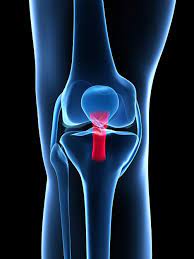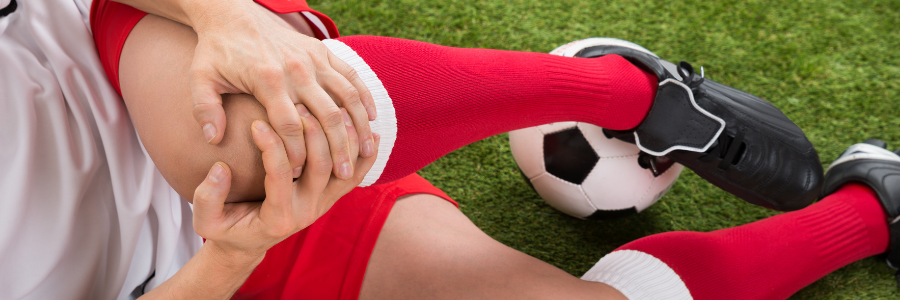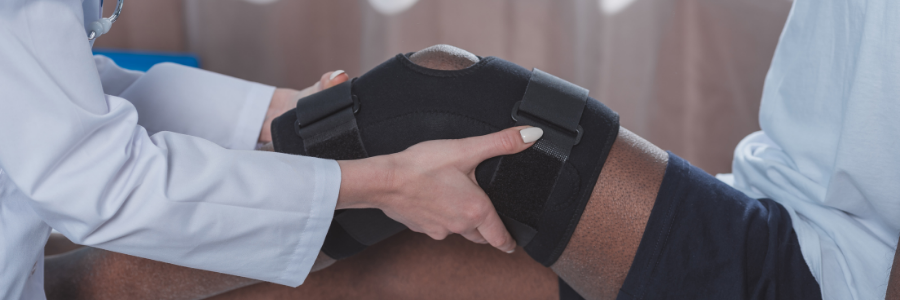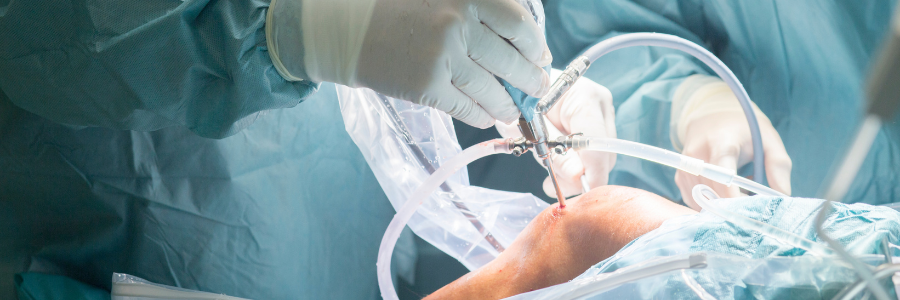ACL Sprain Treatment in Dallas & Frisco, TX
Knee Arthroscopy, ACL Reconstruction
At SPORT Orthopedics and Physical Therapy, we offer personalized treatment plans for each and every patient. If you sprain an ACL while playing sports or performing your everyday activities, we can help. We offer non-surgical treatment, surgical treatment, and physical therapy at our locations. To work with a compassionate doctor after your injury, contact SPORT today. Call our office to schedule an appointment at 469-200-2832 or fill out our online intake form.
What Are ACL Injuries?
A tear or sprain of the anterior cruciate ligament, one of the robust strips of tissue that connects your thigh bone to your shinbone, is known as an ACL injury. ACL injuries are most frequent in sports like soccer, basketball, football, and downhill skiing, which entail rapid pauses or changes in direction, jumping, and landings.
When ACL damage happens, many patients hear or feel a popping sensation in their knee. It’s possible that your knee will expand, become unstable, and become too painful to bear weight on.
Resting and rehabilitative exercises can help you restore strength and stability, or surgery to repair the torn ligament followed by rehab, depending on the degree of your ACL damage. An effective training program can serve to lower the chance of ACL damage. Additionally, many people confuse ACL and MCL injuries. However, they are notably different in many ways.

What’s the Difference Between an ACL Sprain and an ACL Tear?
The two main types of ACL injuries are a sprain and a tear. An ACL tear is as it sounds – a tear in the anterior cruciate ligament. These tears are generally classified as either partial or complete. A sprain simply means the ligament is stretched, not torn. There are three main grades of ACL injuries, which we list below.
- Grade 1: The ligament is preserved, and the joint is stable, but the ACL has undergone minimal stretching and may have experienced microscopic tearing. Typically, surgery is not required for ACL sprains.
- Grade 2 (partial tear): There has been some tearing, and the ligament fibers have separated. The knees are in a state of mild instability. Depending on the person’s level of exercise and the extent of instability, this rating may or may not necessitate surgery.
- Grade 3 (complete tear): The ligament fibers have been completely torn in ACL tears. The ligament is entirely torn, and the knee joint is unstable. Surgical intervention is frequently required for a complete tear of the ACL, as the level of knee instability is high.
How Can I Tell if My ACL Is Torn?

The best way to determine the cause of an ACL injury is to see an orthopedic specialist in Dallas. However, there are a few telltale signs of an ACL injury to look out for. We list these below.
- If you hear a loud pop, you might have a torn ACL or other knee injury. This popping noise occurs because of how tight the anterior cruciate ligament is naturally. As it experiences strain, the motion is similar to the snapping of a rubber band. This sensation often surprises patients and even those around them.
- If you feel pain immediately after hearing the pop, you probably have injured ligaments. Movements like bending and twisting tend to worsen the pain.
- The knee often swells up after it suffers damage. This is due to the amount of fluid and blood it holds as a joint.
- The ACL is crucial for knee stability. Thus, when it suffers damage, many people experience at least moderate knee instability.
- An unstable knee joint affects the entire knee, as it impedes the ability of the leg muscles to work together for functionality.
- If the knee buckles after the injury occurs, you may have either a tear or a sprain.
What Is the Best Way to Diagnose an ACL Sprain?
Speak with your trusted orthopedic surgeon to both diagnose and treat your ACL tear or other ACL injury. Most ACL tears and sprains can be fairly evident from the start. However, most orthopaedic surgeons start with taking a basic medical history. Then they will examine your knee and its range of motion. In order to confirm a diagnosis and begin proper treatment, they will likely order magnetic resonance imaging, X-rays, or other imaging tests.
What Causes an ACL Sprain?
If your knee joint is pushed backward, twisted, or sideways, your ACL might be damaged. If more than one of these motions occur at the same moment, the risk of damage increases. An ACL injury can also occur as a result of contact or being struck by another person or item.
Those who play sports are more likely to sprain an ACL than those who don’t due to the nature of the activities. Sudden stops as well as jumping and landing have the potential to result in a complete or partial disruption of the tissue band. It can also happen when the knee position changes suddenly, such as when something strikes the leg and bends it unnaturally. Sports medicine doctors often see injuries to the anterior cruciate ligament, the posterior cruciate ligament, articular cartilage, patellar tendon, quadriceps tendon, and hamstring tendons in athletes.
What Are the Symptoms of an ACL Sprain?
Symptoms of an ACL injury include the following.
- A popping sensation in the affected knee at the time of the injury
- Feeling pain around the outside and back of the knee
- Swelling of the knee within a few hours of the injury. Sudden swelling often indicates a more serious injury.
- Limited movement in the knee due to pain and/or swelling
- Knee instability or the knee feels as though it will give out
You’ll usually have to stop doing whatever you’re doing because of the discomfort, although you might be able to walk after an acute injury. The major indication of chronic ACL deficiency is collapsing or giving out of the knee, which can be accompanied by pain and edema. When an ACL injury is not addressed, this can happen.
How to Treat an ACL Sprain
First aid care immediately following the injury should include the RICE technique. We outline this method below.
- Rest: Resting is essential for many injuries and illnesses. It promotes healing by limiting the weight that your knee has to bear.
- Ice: While awake, we recommend icing your knee at least every 2 hours for no more than 20 minutes at a time. This helps to reduce swelling.
- Compression: You can apply an elastic band or compression bandage around your knee to apply pressure and keep the knee joint stable.
- Elevation: While resting, lie down and prop your knees up on pillows.
Nonsurgical Treatment

Care generally begins with nonsurgical rehabilitation and physical therapy for at least a few weeks. Your Dallas physical therapist can help you with exercise training to show you the proper exercise techniques. Depending on your specific needs, you will perform these exercises under supervision, at home, or both. They may also require you to wear a knee brace or crutches for added stability and to take the weight off the affected knee.
Sometimes, we recommend knee gel injections for our patients. These injections are a simple, fast, and effective way to manage pain in the knee and to lubricate the joint for smoother movement.
We plan your physical therapy with three goals in mind: reduce pain and swelling, strengthen the muscles, and improve or restore your range of motion. Depending on the severity of your case, we will fully personalize your treatment plan according to your usual level of activity. For more severe cases, such as complete tears, your doctor may require ACL reconstruction surgery.
Surgical Treatment

In certain situations, doctors may recommend surgery even after the physical therapy and other forms of nonsurgical treatment. They often recommend surgery in the following situations.
- Their patient is an athlete who plans to continue in their sport, which involves pivoting, cutting, jumping and landing.
- Multiple ligaments or fibers around the knee bones suffered injuries.
- The injury is causing the knee to buckle during everyday activities.
During ACL reconstruction surgery, your surgeon will remove the damaged or torn ligament and replace it with a portion of tendon. This tissue graft acts similarly to the original ligament in function. Generally, surgeons use grafts from other parts of the knee, or they use a cadaver graft from a deceased person.
Following arthroscopic knee surgery, you’ll begin a new round of rehabilitative treatment. Your knee may generally be stabilized and functional again after a successful ACL replacement and vigorous rehabilitation.
Athletes have no predetermined time limit for returning to play. According to a recent study, up to one-third of athletes will get another knee injury in the same or opposite knee within two years. The chance of re-injury may be reduced with a longer healing period.
Typically, it takes a year or more for players to be able to return to their sport safely. At various points during your recovery, doctors and physical therapists will do tests to assess your knee’s integrity, strength, functionality, and ability to return to athletic activities. Before returning to an activity that puts your ACL in danger, be sure your strength, balance, and motor function are all in good shape.
How Long Does It Take an ACL Sprain to Heal?
This depends entirely on the severity of the injury, as well as the methods of treatment employed by your doctor. Sprains of grade 1 normally recover in a few weeks. When the fibers have fully grown and healed, ligament strength will be at its peak after six weeks.
When Grade 2 sprains develop, it’s critical to use a brace or tape to reinforce the repairing ligament fibers as soon as possible. This helps to alleviate the discomfort produced by the mending ligament straining. Once the joint has stabilized and you are no longer in discomfort, you can return to sports. It might take up to six weeks for this to happen.
When a Grade 3 injury develops, the knee must be braced externally since it is no longer able to act as a hinge. According to the ligament that was injured, there is a risk that it will not mend, necessitating surgery. The goal of conservative therapy is to enable ligaments to recover and return to normal activities gradually. This type of injury can keep you out of sports for at least 2 to 3 months, and up to 12 months if reconstructive surgery is necessary. It’s important to speak with a specialist about proper sports techniques to prevent further injury when you return to play.
Can a Sprained ACL Heal on Its Own?
Because there is no blood flow to the ACL, it cannot repair on its own. The ACL is necessary for sportsmen to safely perform the sharp motions required in sports, hence surgery is frequently required.
Contact SPORT Orthopedics and Physical Therapy Today
If you experience a sprained ACL or ACL tear, the specialists at SPORT Orthopedics and Physical Therapy are here for you. A sprain has the potential to worsen into an ACL tear, but with proper care and treatment, we’ll have you back on the field in no time. With the help of our Dallas orthopedic surgeons and physical therapists, we offer exercise training, personalized rehabilitation, and a treatment plan that works for you. To schedule an appointment with us, please call 469-200-2832 or fill out our online intake form.


